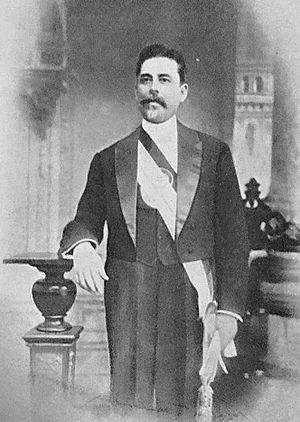Benigno Ferreira facts for kids
Quick facts for kids
Benigno Ferreira
|
|
|---|---|
 |
|
| 19th President of Paraguay | |
| In office November 25, 1906 – July 4, 1908 |
|
| Vice President | Emiliano González Navero |
| Preceded by | Cecilio Báez |
| Succeeded by | Emiliano González Navero |
| Personal details | |
| Born | January 13, 1846 |
| Died | June 14, 1920 (aged 74) |
| Nationality | Paraguayan |
| Political party | Liberal |
Benigno Asunción Ferreira (born January 13, 1846 – died June 14, 1920) was the President of Paraguay from November 25, 1906, to July 4, 1908. He was a member of the Liberal Party. Benigno Ferreira was a general and a doctor. He was a very important leader in Paraguay after the war in the 1870s. Many people respected him.
Contents
Early Life and Education
Benigno Ferreira was born on January 13, 1846, in Tapuá Grande, which is now called Limpio. His parents were María Concepción Ferreira and Angel Joaquín Mora Coene. His parents could not officially marry because the leader at the time, Francia, did not allow it. Even though his father recognized him, Benigno chose to use his mother's last name, Ferreira.
When Benigno was young, he was not allowed to attend the Colegio de San Carlos in Asunción. This was because his father was against the president, Don Carlos Antonio López. However, he got a scholarship from the Argentine consul general, Jose Tomas Ramirez. This scholarship allowed him to study at the College of Concepción in Uruguay, in the province of Entre Ríos, Argentina. There, he met other young people from Argentina and Paraguay.
Later, he moved to Buenos Aires to study law at the university. But his studies were stopped in 1865 when a war broke out against Paraguay.
Getting Involved in Politics
Many Paraguayan families lived in Buenos Aires because they had left their home country for political reasons. They believed in liberal ideas and did not like the strict rules of the Lopez family who ruled Paraguay. A group of young Paraguayan students, including Benigno, started to work together against the government in Asuncion.
They wrote articles in newspapers in Buenos Aires and signed public statements. Benigno Ferreira strongly believed in freedom and liberal ideas, just like other young people.
The government in Paraguay watched these activities closely. Benigno's mother faced difficulties because of his political actions. Seeing his mother's struggles made Benigno even more determined to take a stand. At 19, he joined the Paraguayan Legion, a group of Paraguayans who fought against the Lopez government.
When Benigno learned about the secret Treaty of the Triple Alliance, which was an agreement against Paraguay, he felt it was unfair. He went to General Urquiza and told him that the treaty was a "disgrace" and an "insult" to his homeland. Ferreira then left the Legion and went back to Buenos Aires. He worked as a journalist for the newspaper "La Republica," where he continued to criticize the Alliance.
After the city of Asuncion was taken over, Benigno Ferreira became the captain of the port of the capital in September 1869. The next month, he helped start a newspaper called "La Regeneración." In 1870, he became a member of "The Great People's Club" committee and later took charge of a group in the National Guard.
Leading the Country
From a young age, Benigno Ferreira was active in national politics. In 1871, he became the Minister of War and Navy during the government of Cirilo Antonio Rivarola. He also served as a member of the Lower House and later as the Minister of Justice.
He faced several challenges, including three armed conflicts in 1873 and 1874. Because of these conflicts, he had to live in exile (away from Paraguay) for a long time, from 1874 to 1895. During this time, he earned a law degree in Buenos Aires.
When he returned to Paraguay, the Liberal Party was divided into two groups. He played an active role in the civil war of 1904. After the new government was formed, he again became the Minister of War and Navy. Later, he joined the Superior Court.
On November 25, 1906, Benigno Ferreira became the President of Paraguay. His vice president was Don Emiliano González Navero. His main cabinet members included Adolfo R. Soler as Finance Minister, Manuel Brítez as Interior Minister, and Cecilio Báez as Chancellor.
What His Government Did
During his time as president, Benigno Ferreira's government achieved several important things:
- They set up new telegraph lines to improve communication.
- The Normal Teachers School was moved to Villarica.
- The number of primary schools increased, helping more children get an education.
- They closed military courses and built new army buildings in towns outside the capital.
- A new building for customs in the capital was constructed.
- His government solved a long-standing disagreement with a large railroad company.
- The Bank of the Republic was started.
- The Soler-Pinilla treaty was signed with Bolivia, which helped settle border issues.
- They bought military equipment from Europe to strengthen the country's defense.
Later Life and Passing
After his presidency, Benigno Ferreira went into exile again. He passed away in Buenos Aires in 1920. His coffin was brought back to the Government Palace in Asuncion for a public viewing, showing how much he was respected.
See also
 In Spanish: Benigno Ferreira para niños
In Spanish: Benigno Ferreira para niños

